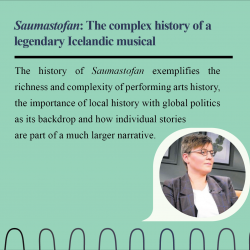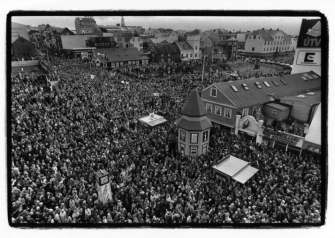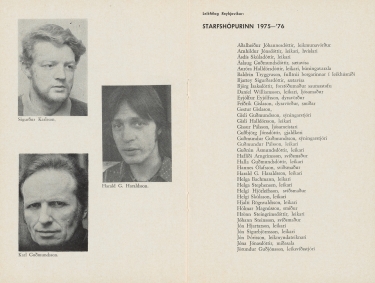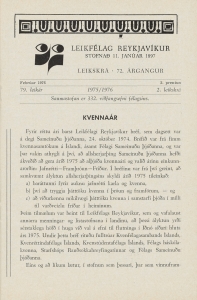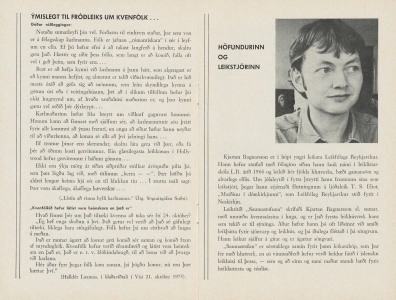2024年10月
To borrow and rework a phrase from Gertrude Stein:
“Iceland is my country and Hong Kong is my hometown.”
As the only member of staff at the Theatre Museum, a performing arts archive located at the National and University Library of Iceland, I am constantly experimenting with new ways of shining a spotlight on the incredible theatre history of the country.
This article is an attempt to string an imaginary thread from Iceland, my country, across the globe to Hong Kong, a city I consider my hometown, by using a very specific example of Icelandic theatre history. This thread crosses both time and space, spanning over 9,500 kilometers and half a century.
Tangled Threads of Unwritten History
The local can have global relevance and theatre history can bring new perspectives to historical events. I want to use a very specific example of theatre history as a case study to explore this statement, an Icelandic musical called Saumastofan by Kjartan Ragnarsson which premiered on the 28th of October 1975 (remember this date) at the Reykjavík City Theatre.
A constant source of excitement, tinged with disappointment, is how much has yet to be written about Icelandic performing arts history. Sure, over the years various and hugely important publications on the topic have been published but research on specific genres and topics is still missing, although a book about Icelandic dance history is forthcoming. This includes in-depth research on the history and development of the Icelandic musical, a performing arts genre often dismissed because of its popular roots, often considered less serious by researchers and critics alike than other theatrical genres.
To set the local stage we must look to the global one. In late 1974 the United Nations announced that 1975 would be International Women’s Year. This was to highlight the ongoing battle for equal rights for women. The artistic director of the Reykjavík City Theatre at the time was Vigdís Finnbogadóttir, the first woman to hold that position in the country and who, a few years later, would become the first woman in the world to be democratically elected as a head of state. In the playbill of Saumastofan, Vigdís tells of a letter sent to the theatre company, dated 24th October 1974 signed by six women’s associations challenging the theatre company, and other cultural institutions, to keep the International Women’s Year in mind when programming the next season.
A year later to the day, 24th October 1975, Icelandic women went on strike setting in motion the biggest mass protest the country had ever seen. Four days later Saumastofan premiered…
Left: Women’s Strike in Iceland, 24th October 1975 (Photo provided by the Women’s History Archive);
Right: A scene from Saumastofan (Photo provided by the Reykjavík Municipal Archive, collection nr. 3)
Saumastofan and The Women
The challenge of writing about Saumastofan in English starts with the title. One can translate the title in two ways: The Sewing Room or The Sewing Firm. Neither is satisfactory as the original title can refer both to a workplace and space in the home. The musical happens over one working day at the sewing company Saumur (Seam). When the owner is away, the six women working at the company decide to turn the machines off and celebrate the 70th birthday of the oldest seamstress.
The group is mostly working class, although some are climbing the social ladder and others have lost their middle-class status. The oldest is 70 and the youngest is 18. After deciding to celebrate, they get to know each other and share glimpses of their personal lives, often through songs. While one woman sings the others reenact their stories, putting on men’s clothes and stepping into the roles of the men in their lives. They are now in control of their own stories and find strength from each other. It is worth giving a short description of these women because they are very real and over the decades people in Iceland only remember the songs, not the harsh social reality that grounds the musical.
The cast of Saumastofan from the playbill of Saumastofan
(Photo provided by the Theatre Museum, National and University Library of Iceland)
Sigga, the oldest of the seamstresses, celebrated her 70th birthday the day before and threw a party; only two guests came. She decides to bring all the leftover food and wine to work and share with her colleagues. Quick side note, my grandmother was also called Sigga and was also a seamstress, I’m named after her. Magga is the foreperson whose husband used to own a share in the sewing company. He organised the family life but turned to drinking, destroying their lives through abusive behaviour and eventually had to sell his share to the current owner, his former partner.
Ása is riding fast on the consumerist highway, building a house with her husband and they just bought a caravan. They are going further and further into debt trying to keep up with the Jones. She works long hours and her husband is developing a gastric ulcer. Gunna is an alcoholic. She wants freedom from everyday life and seeks refuge in the bottle, but after her baby son dies for which she blames herself, she has lost all control and ended up on the streets.
Didda is a single mother of two whose partner had an affair, destroying their seven-year relationship. Because they were not married, he kept everything: the flat, the car, the summer cabin; and she is left destitute. Lilla, the youngest, is pregnant, again. Her mother died when Lilla was young and she became pregnant at fourteen. The implication is that she was sexually assaulted, but with the help of an older woman she had an illegal abortion.
There are three men at the company. Siggi, the owner and a symbol of the past, Himmi, the delivery boy and a symbol of the future, and Kalli, the company tailor. Kalli is the only man in the play who has a song of his own but perhaps because he might have more in common with the women as Kalli is gay. And intriguingly, the character of Kalli might be the first homosexual character in an Icelandic play.
And yes, this is a gloriously funny musical and has become an instant runaway hit in Iceland almost fifty years ago. According to the Theatre Museum’s database the musical was performed around 150 times at the Reykjavík City Theatre over three seasons and also toured the country. The final tally could be close to 200 performances.
Pieces of Performance History
Saumastofan also exemplifies the work involved in piecing together the history of one specific production. The script of the play was never formally published, as is the fate of most Icelandic plays, but two working scripts were produced by the theatre company. These copies were donated to the Theatre Museum in 2021 when the Reykjavík City Theatre dismantled their library. If other copies exist, they are privately owned and not accessible to the public.
Over the past two years, a colleague and I have been meticulously cataloging playbills at the National Library, which has a mandate of collecting printed materials. There are two different playbills and one leaflet on record, there might be more, and these contain invaluable information like Vigdís’s note.
The short article by Vigdís Finnbogadóttir, then artistic director of the Reykjavík City Theatre, in the playbill for Saumastofan titled “Women’s Year”
(Photo provied by the Theatre Museum, National and University Library of Iceland)
Due to the production’s popularity, an album of the songs was released, and three copies are stored at the National Library. Additionally, there was an audio recording made of the production in full. I know this because the tape is stored at the Theatre Museum. However, only the first half of the production remains. In 1986, there was a fire in the building that housed both the Reykjavík City Theatre costume collection and the audio/visual archive, the entire costume collection went up in flames and most of the archive.
Original photos from the production are located at the Reykjavík Municipal Archive, the model of the set, designed by Jón Þórisson, is currently located at Borgarleikhúsið, the home of the Reykjavík City Theatre, and various newspaper articles are available online through timarit.is, an online resource for magazines and newspapers.
Finally, there is one crucial component missing when piecing together performance history: Oral history.
The Tapestry of the Past and the Present
On the surface all the key elements are in place: The International Women’s Year, the letter from the women’s association, Vigdís Finnbogadóttir and Kjartan Ragnarsson. However, history is never straightforward and filled with twists and turns. There was another key catalyst in the production history, the actor and translator Karl Guðmundsson.
This past September a celebration was held at Borgarleikhúsið in honour of Karl, the actor who originated the role of the tailor Kalli and would have turned 100 years old in August of this year. At the event, Kjartan Ragnarsson, the author and director of Saumastofan, held a speech remembering his old friend.
Kjartan told the following story, which exemplifies the magnificent messiness of history and the importance of its driving force, people. Karl had recently translated Murder in the Cathedral by T.S. Eliot into Icelandic. Being a meticulous translator, he often translated the same line in three different ways. One night Karl and Kjartan sat down and cobbled together a final version of the script. When the translated version was to be staged by the Reykjavík City Theatre Company, Karl insisted that Kjartan, then a young actor at the company, would direct the production. Subsequently, Vigdís offered Kjartan to direct the Assemblywomen by Aristophanes in celebration of the International Women’s Year. However, when it came to rehearsals in late spring, the translator chosen for the Aristophanes play had barely begun the work. According to Kjartan he suggested to the cast, already assembled, that the group would write a play about working class women. Eager to go on holiday, the group passed on the project. Kjartan decided to write the play himself, his first play. And that play became the musical Saumastofan.
The Great Sewing Project Continues
The history of Saumastofan exemplifies the richness and complexity of performing arts history, the importance of local history with global politics as its backdrop and how individual stories are part of a much larger narrative.
One might say that Saumastofan reached the stage partly because of Vigdís Finnbogadóttir and Vigdís Finnbogadóttir partly became the first democratically elected female head of state because of Saumastofan. And both would not have been possible if not for the International Women’s Year in 1975 and the Women’s Strike in Iceland. Of course, this is wild conjecture, but part of my job is to create sparks of interests and shine a light on unexplored corners of Icelandic cultural history.
The 24th of October 2025 will be 50 years since the Women’s Strike in Iceland. Four days later will be 50 years since the premiere of Saumastofan. There is much work left to be done…
Left: Kjartan Ragnarsson; Right: Vigdís Finnbogadóttir
(Photo provided by the Theatre Museum, National and University Library of Iceland)
References:
The Theatre Museum of Iceland - https://leikminjasafn.is/
The Icelandic Women’s Strike - https://kvennasogusafn.is/index.php?page=kvennafri_1975
An exhibition about the life and work of Vigdís Finnbogadóttir -
https://www.hi.is/frettir/ljadu_mer_vaengi_opid_hus_i_loftskeytastodinni_og_verold_um_helgina
“The extension of the women’s year in Iðnó [Reykjavik City Theatre Company]” -
https://timarit.is/page/3064883
本網站內一切內容之版權均屬國際演藝評論家協會(香港分會)及原作者所有,未經本會及/或原作者書面同意,不得轉載。











